传统建筑文化英文
- 格式:ppt
- 大小:10.17 MB
- 文档页数:10

中国建筑英语介绍文章范文阅读中国古典建筑算是举世闻名的,如今独具特色的新建筑物也犹如雨后春笋般地出现。
今天店铺整理了介绍中国建筑的英语文章,希望大家喜欢!介绍中国建筑的英语文章篇一The Ancient Architecture中国古代建筑艺术Chinese architecture is an independent art featuring wooden structures. It consists of various roof molding, upturned eaves and wings, dougong with paintings, vermilion pillars and golden roofs, ornament gates and gardening. All of these embody the maturity and artistic appeal of Chinese architecture. 7000 years ago, mortise and tenon and tongue-and-groove were used in Hemudu. The buildings of Banpo village had the division of antechamber and back rooms. Great palaces were built in Shangyin period. Bricks and tiles were used and the layout of Siheyuan emerged in the Western Zhou. There are even building drawings in Spring and Autumn and the Warring States periods passed down.中国建筑体系是以木结构为特色阳的建筑艺术。
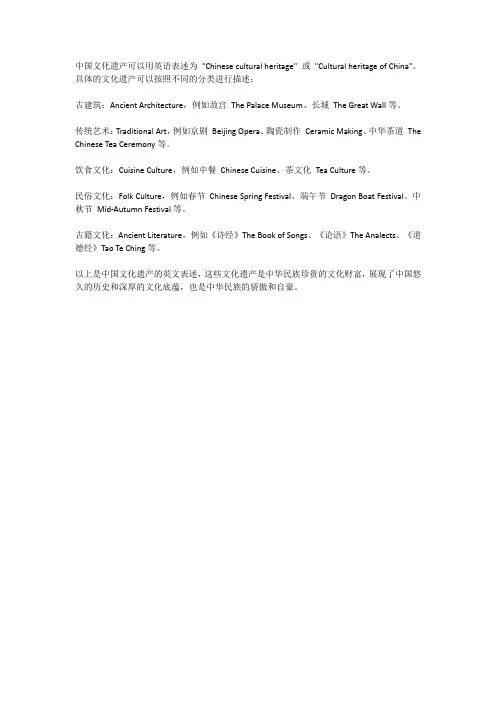
中国文化遗产可以用英语表述为"Chinese cultural heritage" 或"Cultural heritage of China"。
具体的文化遗产可以按照不同的分类进行描述:
古建筑:Ancient Architecture,例如故宫The Palace Museum、长城The Great Wall等。
传统艺术:Traditional Art,例如京剧Beijing Opera、陶瓷制作Ceramic Making、中华茶道The Chinese Tea Ceremony等。
饮食文化:Cuisine Culture,例如中餐Chinese Cuisine、茶文化Tea Culture等。
民俗文化:Folk Culture,例如春节Chinese Spring Festival、端午节Dragon Boat Festival、中秋节Mid-Autumn Festival等。
古籍文化:Ancient Literature,例如《诗经》The Book of Songs、《论语》The Analects、《道德经》Tao Te Ching等。
以上是中国文化遗产的英文表述,这些文化遗产是中华民族珍贵的文化财富,展现了中国悠久的历史和深厚的文化底蕴,也是中华民族的骄傲和自豪。

中国古典园林---- c lassical Chinese garden中国传统园林---- t raditional Chinese garden中国古代园林---- a ncient Chinese garden中国山水园------ C hinese mountain and water garden帝王宫苑----- imperial palace garden皇家园林----- royal garden私家园林----- private garden江南园林-------- g arden on the Yangtze Delta西方古典园林-------- western classical garden英国式园林------------- English style garden中英混合式园林--------- Anglo-Chinese style garden意大利式园林----------- Italian style garden西班牙式园林----------- Spainish style garden法兰西式园林----------- French style garden勒诺特尔式园林--------- Le Notre\'s style garden文艺复兴庄园------------- Renaissance style garden洛可可式园林--------------- Rococo style garden巴洛克式园林------------- Baroque style garden庄园---------------- manor,villa garden廊柱园-------------- peristyle garden,patio绿廊---------------- xystus迷阵---------------- maze,labyrinth灵囿---------------- Ling You Hunting Garden 周代术语灵沼--------- Ling Zhao Water Garden 周代术语灵台--------- Ling Tai Platform Garden 周代术语阿房宫------- E-Pang Palace 秦代术语上林苑---------- S hang-Lin Yuan 汉代术语未央宫---------- W ei-Yang Palace 汉代术语洛阳宫---------- L uoyang Palace 魏代术语华清宫---------- H ua-Qing Palace 唐代术语艮岳------------ G en Yue Imperial Garden 宋代术语圆明园---------- Y uan-Ming Yuan Imperial Garden颐和园------------ Yi-HE Yuan Imperial Garden承德避暑山庄-------- Chengde Imperial Summer Resort苏州园林------------ Suzhou traditional garden悬园------ Hanging Garden 又称“悬空园” ,“架高园” 。
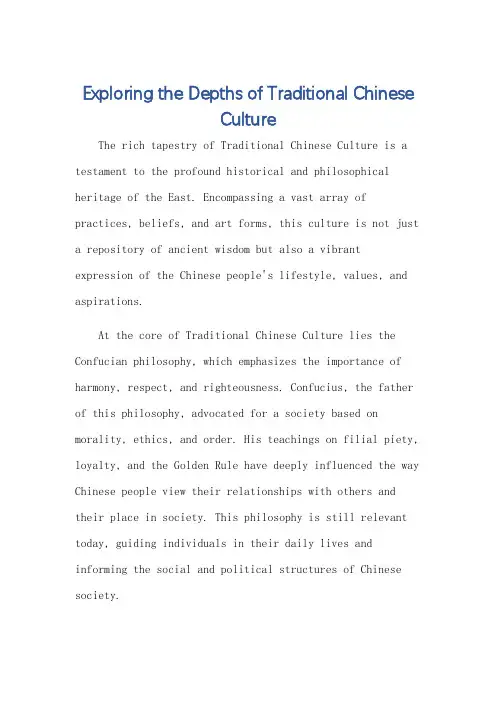
Exploring the Depths of Traditional ChineseCultureThe rich tapestry of Traditional Chinese Culture is a testament to the profound historical and philosophical heritage of the East. Encompassing a vast array of practices, beliefs, and art forms, this culture is not just a repository of ancient wisdom but also a vibrant expression of the Chinese people's lifestyle, values, and aspirations.At the core of Traditional Chinese Culture lies the Confucian philosophy, which emphasizes the importance of harmony, respect, and righteousness. Confucius, the father of this philosophy, advocated for a society based on morality, ethics, and order. His teachings on filial piety, loyalty, and the Golden Rule have deeply influenced the way Chinese people view their relationships with others and their place in society. This philosophy is still relevant today, guiding individuals in their daily lives and informing the social and political structures of Chinese society.Another important aspect of Traditional Chinese Culture is its rich artistic heritage. Chinese art, whether it be painting, calligraphy, pottery, or architecture, is renowned for its elegance, simplicity, and profound symbolism. The use of natural elements like water, stones, and flowers as motifs in art represents the Chineseaffinity with nature and their belief in the harmony of man with his surroundings. Calligraphy, in particular, is considered an extension of one's character and personality, with each stroke carrying deep meaning and emotional value. Music and dance are also integral to Chinese culture. Traditional Chinese instruments like the guqin, pipa, and drums create melodies that are both soothing and uplifting. These instruments, along with traditional dance forms like the dragon dance and lion dance, are often performed during festivals and special occasions, reflecting the joy and vitality of the Chinese people.The Chinese calendar is also a unique aspect of this culture, with each month, day, and season associated with specific meanings and celebrations. The Chinese New Year, for instance, is a time for family reunions, giving redenvelopes, and setting off fireworks to驱逐邪恶和迎来好运. These practices are deeply rooted in Chinese history and tradition, serving as a reminder of their cultural identity and heritage.In conclusion, Traditional Chinese Culture is a vast and diverse field that encompasses various aspects of life, from philosophy and art to music, dance, and festivals. This culture, with its unique blend of ancient wisdom and modern vitality, continues to inspire and influence people around the world, making it an integral part of global cultural heritage.**探寻中国传统文化的深厚底蕴**中国传统文化是一幅丰富多彩的织锦,见证了东方古老历史和哲学遗产的深厚底蕴。
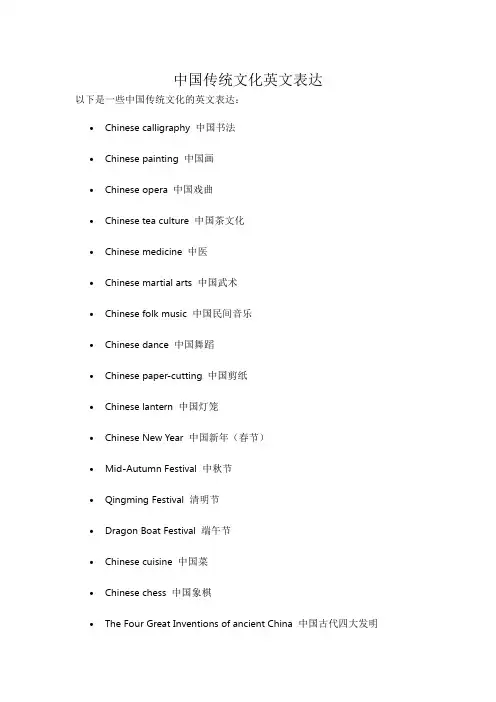
中国传统文化英文表达
以下是一些中国传统文化的英文表达:
•Chinese calligraphy 中国书法
•Chinese painting 中国画
•Chinese opera 中国戏曲
•Chinese tea culture 中国茶文化
•Chinese medicine 中医
•Chinese martial arts 中国武术
•Chinese folk music 中国民间音乐
•Chinese dance 中国舞蹈
•Chinese paper-cutting 中国剪纸
•Chinese lantern 中国灯笼
•Chinese New Year 中国新年(春节)
•Mid-Autumn Festival 中秋节
•Qingming Festival 清明节
•Dragon Boat Festival 端午节
•Chinese cuisine 中国菜
•Chinese chess 中国象棋
•The Four Great Inventions of ancient China 中国古代四大发明
这些只是中国传统文化的一部分,还有很多其他方面的文化元素,如传统服饰、建筑、文学、哲学等。
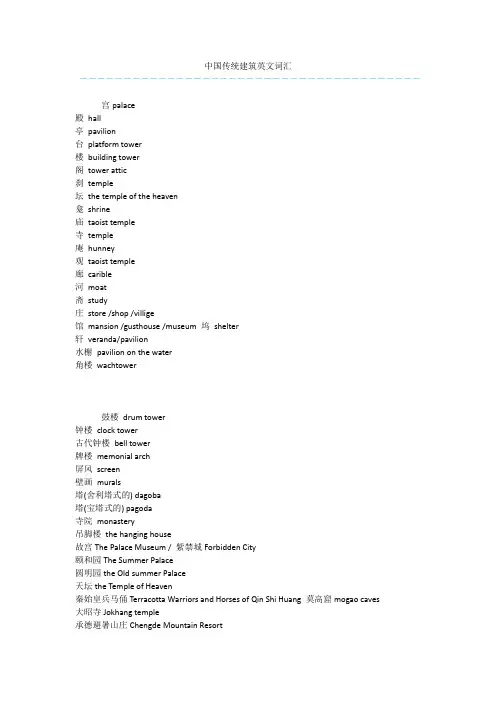
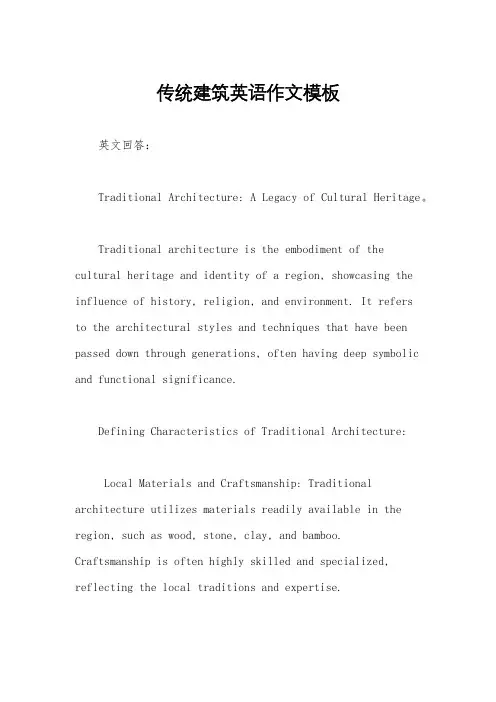
传统建筑英语作文模板英文回答:Traditional Architecture: A Legacy of Cultural Heritage。
Traditional architecture is the embodiment of the cultural heritage and identity of a region, showcasing the influence of history, religion, and environment. It refersto the architectural styles and techniques that have been passed down through generations, often having deep symbolic and functional significance.Defining Characteristics of Traditional Architecture:Local Materials and Craftsmanship: Traditional architecture utilizes materials readily available in the region, such as wood, stone, clay, and bamboo. Craftsmanship is often highly skilled and specialized, reflecting the local traditions and expertise.Climate Adaptation: Buildings are designed to respond to the local climate, providing shelter from extreme temperatures, wind, and precipitation. Passive design principles, such as natural ventilation and daylighting, are often employed.Regional Styles: Traditional architecture varies widely across regions, influenced by cultural, historical, and geographical factors. Examples include the traditional mosques of the Middle East, the wooden houses of Japan, and the ornate temples of India.Symbolic Elements: In many cultures, traditional architecture incorporates symbolic elements that convey religious, social, or cultural meanings. This may include decorative motifs, architectural forms, or the use of specific colors and materials.Community Involvement: Traditional architecture often involves the participation of the local community, who contribute to the design, construction, and maintenance of buildings. This fosters a sense of ownership and pride.Preservation and Conservation:Preserving traditional architecture is crucial for safeguarding cultural heritage and ensuring its continuity for future generations. Conservation efforts involve:Documentation and Research: Recording thearchitectural details, history, and significance of traditional buildings is essential for preserving knowledge and promoting their appreciation.Adaptive Reuse: Finding new uses for historicbuildings can extend their lifespan and ensure their continued relevance. This involves balancing conservation principles with modern functionality.Community Engagement: Involving local communities in preservation efforts is vital for maintaining a sense of connection and ownership. Education and awareness-raising initiatives can foster appreciation and support.Government Support: Government policies and regulations can provide incentives for the conservation of traditional architecture. This may include financial assistance, tax breaks, or designation as historical landmarks.Conclusion:Traditional architecture is a testament to the ingenuity, creativity, and cultural heritage of our ancestors. Its preservation and conservation ensure that future generations can experience and appreciate the richness and diversity of human architectural expression. By embracing and understanding the values and principles of traditional architecture, we can continue to build sustainable, resilient, and culturally meaningful environments.中文回答:传统建筑,文化遗产的传承。
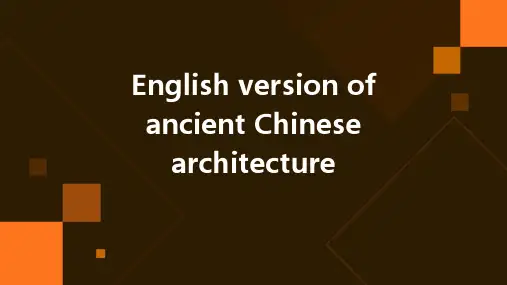
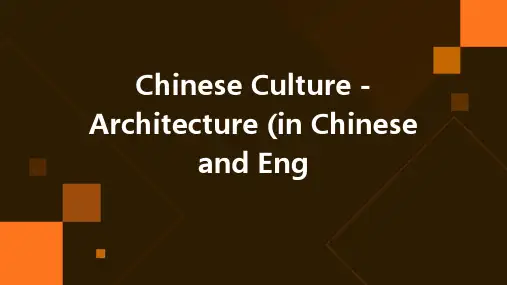
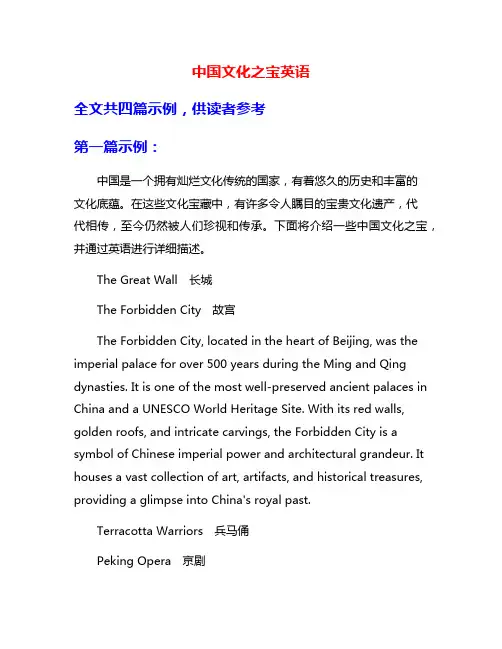
中国文化之宝英语全文共四篇示例,供读者参考第一篇示例:中国是一个拥有灿烂文化传统的国家,有着悠久的历史和丰富的文化底蕴。
在这些文化宝藏中,有许多令人瞩目的宝贵文化遗产,代代相传,至今仍然被人们珍视和传承。
下面将介绍一些中国文化之宝,并通过英语进行详细描述。
The Great Wall 长城The Forbidden City 故宫The Forbidden City, located in the heart of Beijing, was the imperial palace for over 500 years during the Ming and Qing dynasties. It is one of the most well-preserved ancient palaces in China and a UNESCO World Heritage Site. With its red walls, golden roofs, and intricate carvings, the Forbidden City is a symbol of Chinese imperial power and architectural grandeur. It houses a vast collection of art, artifacts, and historical treasures, providing a glimpse into China's royal past.Terracotta Warriors 兵马俑Peking Opera 京剧Chinese Calligraphy 中国书法Tea Culture 茶文化Conclusion 总结以上就是关于【中国文化之宝英语】的文章,希望能够为您提供一些有用的信息。
谢谢阅读!第二篇示例:中国文化源远流长,拥有众多珍贵的文化遗产,代代相传。

The Elegance of Chinese ArchitectureAmidst the bustling streets of China, one cannot help but marvel at the array of architectural wonders that dot the landscape. From the ancient temples and palaces to the modern skyscrapers, Chinese architecture embodies a unique blend of tradition and modernity, reflecting the rich history and vibrant culture of the country.The ancient temples, with their intricate carvings and tiled roofs, are testaments to the skilled craftsmanship of the past. These structures, often made of wood and stone, exude a sense of serenity and respect, inviting passersby to pause and pay homage. The details on these temples, such as the intricate carvings on the beams and the elaborate tiled roofs, are not just aesthetic; they also carry deep cultural and historical meanings.Palaces, on the other hand, are a testament to the grandeur and power of the Chinese emperors. With their towering gates, vast courtyards, and intricate details, these palaces were not just places of residence but also symbols of imperial might and wealth. The Forbidden City in Beijing, for instance, is a prime example of such grandeur,with its red walls and golden roofs shining in the sun, it remains a fixture of the Chinese capital's skyline.Modern Chinese architecture, however, is a stark contrast to the traditional styles. Skyscrapers, with their glass façades and steel frames, dot the skylines of cities like Shanghai and Shenzhen, symbolizing the country's rapid economic growth and urbanization. These buildings, while modern in design, often incorporate traditional elements, such as tiled roofs or ornamental details, in a nod to the country's rich cultural heritage.One of the most remarkable aspects of Chinese architecture is its adaptability. Whether it's atraditional temple or a modern skyscraper, Chinese architects have always been able to blend traditional elements with modern design, creating structures that are both functionally effective and aesthetically pleasing. This ability to innovate while staying true to tradition is what makes Chinese architecture truly unique.The beauty of Chinese architecture lies not just in its visual appeal but also in its ability to evoke a sense of history and culture. It is a testament to the skilledcraftsmanship of the past and a promise of the innovative designs of the future. As one walks through the streets of China, it's impossible not to be moved by the elegance and grandeur of these architectural wonders.**中国建筑的优雅**在中国熙熙攘攘的街道上,人们不禁为中国各地散布的建筑奇观而惊叹。
介绍中国传统建筑的英语作文English:Traditional Chinese architecture is characterized by its unique style, elaborate wooden structures, and emphasis on harmony with nature. The most iconic feature of traditional Chinese architecture is the curved and sloping roofs, which are often adorned with intricate carvings and colorful tiles. The wooden columns and beams are also meticulously crafted to create a sense of grace and beauty. Traditional Chinese buildings are typically designed around a central courtyard, with rooms arranged in a symmetrical layout. This layout not only maximizes natural light and ventilation but also promotes a sense of balance and harmony. Additionally, traditional Chinese architecture often incorporates elements of feng shui to create a harmonious and auspicious living environment. Overall, traditional Chinese architecture reflects the cultural values of balance, harmony, and beauty.中文翻译:传统的中国建筑以其独特的风格、精美的木制结构和强调与自然和谐的特点而闻名。
高中英语高考英语作文有关中国传统文化的范文5篇带中文翻译范文一:中国传统节日Chinese traditional festivals play an important role in Chinese culture. Among them, the Spring Festival is the most significant one. It is a time for family reunion, when people gather together, have festive meals, and exchange blessings. The Dragon Boat Festival and Mid-Autumn Festival are also celebrated widely. These festivals not only offer people a chance to relax and enjoy themselves, but also promote traditional values and customs, such as filial piety and respect for ancestors. Through these festivals, we can learn more about Chinese history, traditions, and customs, and pass them on to future generations.范文二:中国传统艺术Chinese traditional art, with a history of thousands of years, is a treasure of Chinese culture. Calligraphy, for example, is considered as the essence of Chinese culture. It not only requires skillful brushwork, but also embodies the beauty of Chinese characters. Chinese paintings, known for their unique painting techniques and rich cultural connotations, are admired by people all over the world. In addition, traditional Chinese music, opera, and dance are also highly appreciated for their elegance and grace. These art forms not only reflect the aesthetics of Chinese people, but also convey profound cultural meanings.范文三:中国传统美食Chinese traditional cuisine is renowned worldwide for its diversity and flavors. From the spicy Sichuan cuisine to the delicate Cantonese cuisine, each region has its own specialty dishes. For example, Peking duck, known for its crispy skin and tender meat, is a must-try when visiting Beijing. Dim sum, a variety of bite-sized dishes, is a popular choice for breakfast or afternoon tea in southern China. Chinese cuisine not only satisfies people's taste buds, but also reflects the philosophy of balance and harmony in Chinese culture. The art of Chinese cooking has been passed down from generation to generation, and it continues to evolve and innovate while preserving its traditional roots.范文四:中国传统服饰Traditional Chinese clothing, known as Hanfu, has a long history and unique charm. It is characterized by its loose, flowing silhouette and exquisite craftsmanship. Hanfu consists of various garments, such as the Ruqun for women and the Zhongshan suit for men. Each garment has its own distinctive style and symbolic meaning. Traditional Chinese clothing not only reflects the aesthetic taste of different dynasties, but also represents the etiquette and social status of the wearers. Nowadays, Hanfu is experiencing a revival, and more and more people are embracing it as a way to showcase their cultural identity and appreciation for Chinese traditions.范文五:中国传统建筑Chinese traditional architecture, with its distinctive style and profound cultural connotations, is a true representation of Chinese culture. The Forbidden City in Beijing, with its grandeur and meticulous design, is a masterpiece of traditional Chinese architecture. The classical gardens in Suzhou, known for their harmonious layout and exquisite details, showcase the perfect integration of nature and human creations. Traditional Chinese architecture also emphasizes the balance of Yin and Yang, and the harmony between man and nature. It is not only a manifestation of architectural skills, but also a reflection of the wisdom and philosophy of the Chinese people.范文一:中国传统节日中国传统节日在中国文化中占有重要地位。
中国传统建筑作文英文English:Chinese traditional architecture, characterized by exquisite craftsmanship, intricate wooden structures, and harmonious integration with nature, reflects the unique cultural identity and philosophical beliefs of the Chinese people. From ancient palaces like the Forbidden City to traditional courtyard houses, each building is carefully designed to adhere to the principles of feng shui and yin-yang balance. The use of natural materials like wood, stone, and ceramic tiles not only enhances the aesthetic appeal but also demonstrates a deep respect for the environment. Additionally, traditional Chinese architecture often features curved eaves, decorative motifs like dragons and phoenixes, and intricate lattice windows, all of which symbolize wealth, prosperity, and protection. Moreover, the layout of traditional Chinese buildings follows a symmetrical and hierarchical structure, with the emphasis on creating a harmonious flow of energy known as qi. Overall, Chinese traditional architecture embodies a rich heritage of architectural wisdom and cultural symbolism that continues to inspire generations of architects and designers worldwide.Translated content:中国传统建筑以精湛的工艺、错综复杂的木质结构和与自然的和谐融合为特征,体现了中国人民独特的文化认同和哲学信仰。
中国传统建筑作文英文The Splendor of Traditional Chinese ArchitectureChinese traditional architecture, with its unique charm and profound cultural connotations, has been admired and admired worldwide. It is not only a reflection of the wisdom and creativity of the Chinese people, but also a symbol of the country's rich history and civilization.The most distinctive feature of traditional Chinese architecture lies in its harmony with nature. This is evident in the use of natural materials like wood, brick, and stone, as well as the incorporation of natural elements like water, gardens, and rockeries. The buildings are often designed to blend seamlessly into their surroundings, creating a harmonious coexistence between man and nature.Another noteworthy aspect of Chinese traditional architecture is its emphasis on symmetry and balance. Buildings are often designed with a central axis, with symmetrical wings extending out on both sides. This design principle not only creates a visually pleasing aesthetic, but also reflects the Chinese philosophy of harmony and balance.Furthermore, traditional Chinese architecture is rich in cultural symbols and meanings. For instance, the use of red in buildings signifies good luck and prosperity, while the placement of statues and ornaments often represents the hopes and aspirations of the people. The intricate carvings and decorations on the buildings also reflect the exquisite craftsmanship and artistic tastes of the Chinese people.Moreover, traditional Chinese architecture is known for itsemphasis on functionality and practicality. Buildings are designed to meet the needs of the people, whether it's for living, working, or worshipping. The layout and design of the buildings take into account the climate, environment, and lifestyle of the inhabitants, ensuring that they are comfortable and convenient to use.In conclusion, traditional Chinese architecture is a treasure of the Chinese nation. It not only showcases the wisdom and creativity of the Chinese people, but also embodies the country's rich history and culture. As we move forward into the future, it is important to preserve and promote this valuable cultural heritage, so that it can continue to inspire and influence people worldwide.。